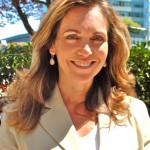HR: The Innovation Driver
By Anya Levykh
Calling all leaders of innovation—please report to HR.
While innovation has been a long-time, buzz word for business, never before has it been quite so closely linked to human resources. The ascended role of HR as a primary driver of innovation reflects a a paradigm shift that has occurred in the last 10 years. Whereas the individual was previously seen as the driver of innovation, he is now more of an interactive link that helps forge the chain-reaction of innovation that organizations are desperately seeking in their quest to bridge the gap.
What, however, is an innovation gap? Dr. David Weiss, president and CEO of Weiss International, Ltd., and author of several books on leadership and innovation, including Innovation Intelligence: The Art and Practice of Leading Sustainable Innovation in Your Organization, has conducted extensive research on this topic. “There is a significant gap that exists in most workforces, where 80 per cent of leaders say that innovation is important, but only about 30 per cent are satisfied with their results” says Weiss. “That difference is called an innovation gap.”
Innovative Intelligence For All
 One of the biggest challenges facing organizations in their quest for innovation is the very nature of the issues with which they must deal.
One of the biggest challenges facing organizations in their quest for innovation is the very nature of the issues with which they must deal.
“In the past, leaders faced complicated problems that needed to be broken down, and precision was essential to the thinking process,” explains Weiss. The approach to solving those types of problems was built on the knowledge and experience that people had accumulated: a decidedly left-brained approach. Weiss calls this analytical intelligence, and acknowledges its success over the whole of the last century—as well as its limitations.
Today, however, organizations are dealing with issues that are more ambiguous in nature, with variable factors and uncertain outcomes. Not having established best practices and precedents on this new playing field means a new way of thinking and problem-solving is required—what Weiss calls innovative intelligence. “Innovative intelligence is really the human cognitive ability to gain insight into problems or opportunities and then discover new or unforeseen implementable solutions.”
Finding innovative leaders, however, is not the solution.
“For many years, we made the mistake of thinking that the way to overcome that innovation gap was to find and develop leaders so that they themselves would be more innovative and have greater skill in demonstrating innovative intelligence,” explains Weiss. “However, most people have developed their cognitive abilities over a 30, 40 or 50-year period, so even with a few training courses here and there, they’re not going to be able to radically rewire their cognitive process—to be able to think differently and demonstrate their innovative intelligence—if they’ve always been thinking and working based on the knowledge and experience that they’ve developed.”
What’s needed, according to Weiss, are leaders of innovation, rather than innovative leaders. “It’s no longer the requirement for leaders to be the ones who generate the innovative idea. Rather, they have to be able to draw out the innovative intelligence from their employees and teams—and diverse teams—to know an innovative idea when they see it, and to combine ideas in different ways, so that they gain insight and discover innovative solutions to complex problems.”
Driving Change at Coast Capital
Jay-Ann Fordy, CHRP, chief transformation officer (former chief HR officer) at Coast Capital Savings, went through such an experience two years ago. A major project to  implement a new banking system needed a new leader and the project—which was behind schedule and off the rails—fell to Fordy.
implement a new banking system needed a new leader and the project—which was behind schedule and off the rails—fell to Fordy.
“There was a small team of people who were going off and doing their own thing with a governance structure that didn’t work, which created a lot of confusion and chaos,” explains Fordy. “The board and CEO took a step back and brought in an independent person to review the situation, and take it in a different direction.” By that time, however, a high level of skepticism had been generated. “No one trusted that this could be done and people joked and asked how an HR person got to be in charge of a banking system implementation, and I would reply that I thought I was the last person standing,” she says with a laugh.
Fordy, however, did not assume that she would be the lone ranger pulling the project out of the fire. “Here I was in charge of a huge technological initiative in banking, and my expertise is not in banking, it’s in people. And now I was in charge of the biggest system change the organization has ever been through, in an area that I knew nothing about. Having HR in my background helped me recognize that I never would be an expert in this area, but I needed to find the people who were, and I needed to build relationships with them, and figure out how we were going to work together to drive this through to the finish line.”
Fordy went on to create systems to get things back on track. “It really starts with the board and CEO. There was a lot of work done on [the technical side of] implementing a new banking system, but some of the strategic thinking, how you galvanize the organization, and deliver the right culture to be able to deliver on how to make communications more open, and how you problem-solve, none of that was inherent in the system,” says Fordy. “Clarity in what you’re trying to accomplish at the most strategic level of the organization is important in terms of how then you apply strategic leadership into any major initiative or program to effect change across the organization. Without that mandate from the head of the organization, it can’t happen.”
Building Teams of Shared Vision
Fordy credits her CEO and board with understanding what needed to be done and embracing it. “The whole organization rallied around this. We had a team that was feeling kind of beaten down and left to hang out to dry because the program wasn’t successful and they weren’t getting the results that they could have. I needed to rebuild the team, get people moving in the same direction. It’s about helping people understand the framework in which you make decisions, getting clear on roles and responsibilities, and making sure people are being held accountable, as well as rewarded and recognized. I also had to find the right people, as I had a talent gap, but that is an HR skill, finding the right skill set for any position.”
Not all leaders are good at finding talent, and “not all leaders are confident in their ability when they hire someone who is smarter than them to let that person make the decisions,” says Fordy. “You need to look at the talent and skills that are required and available, to get the right people on the team, and then the priorities that you need to assign. Building those capabilities and capacities within any sort of team that you form in order to drive change in the organization are critical, as is getting the right balance between the technical and the people skill sets.”
“The next thing you need is to build the trust, commitment and confidence of the team. You need to be able to help them see the big picture and a long-term vision of where you’re going. You need to wade through the concerns and challenges, and the fear of not meeting that vision. It means taking a strategic approach, but taking baby steps to build confidence, trust and a sense of shared ownership. Organizations need to create a culture that allows people to feel free about bringing issues forward and suggesting solutions to those problems. That builds momentum, builds confidence, and builds solutions moving forward.”
Cross-Collaboration Without Fear at CRD
 Sarah Hood, CHRP, manager, workforce development and strategies with the Capital Regional District (CRD), knows something about overcoming fear and creating open communication. An employee survey done at CRD more than five years ago revealed a very high level of dissatisfaction among staff for management and the corporate culture.
Sarah Hood, CHRP, manager, workforce development and strategies with the Capital Regional District (CRD), knows something about overcoming fear and creating open communication. An employee survey done at CRD more than five years ago revealed a very high level of dissatisfaction among staff for management and the corporate culture.
“We developed iLead at that time in response to the need for a change in the culture,” says Hood. “It was a major shift to move away from that traditional, silo-oriented model, with very individual departments doing their own thing, because the Capital Regional District is a very diverse organization. We have over five hundred employees and over four hundred job descriptions. We do everything from arts funding and waste water treatment, to running housing units and landfills. How to bring all of that into a sense of one common organization was the challenge we were facing.”
CRD collaborated with Royal Roads University to develop iLead, an intensive, long-term program designed to develop innovation intelligence. “We [as an organization] were mainly very linear-logical thinkers,” explains Hood, “and part of the iLead program was to learn to understand that there are people who are visual learners or emotional learners, and that there is an emotional side to change. So, it’s learning how to appreciate both left- and right-brain thinking.”
The program consisted of a half-day introduction, followed a month later by a five-day intensive at the Royal Roads campus, and then a two-day follow-up six weeks after completion. “The design of the program was spread out over about four months,” Hood explains, “so that people had that thought of leadership uppermost in their minds and had the ability to reflect. Innovation comes from having that experience and being to reflect and apply what you’ve learned, and then go back and reflect again. That’s the adult learning cycle, in that we’re reflective learners. The whole point of innovation is being able to learn from your experiences and the program was designed to encourage people to do that.”
Innovation in the Mix
Such programs tend to be offered in a top-down approach, with senior executives getting first dibs, followed by managers and supervisors. CRD decided to take a slightly different approach. “We didn’t start at the top and work our way down,” says Hood. “Instead, we did mixed-level groups, in cohorts of 25 people, and even within those mixed level groups, those 25 people worked within smaller groups of five, which were also mixed-level. This was a very safe place for senior managers to be open to participation and actually see the different contributions of different people at multiple levels and places in the organization. And that was huge, it was the biggest benefit of the program, in that it opened the eyes of all of our managers to the smart, talented, and committed people in this organization—people they likely wouldn’t have even talked to if it weren’t for this program.”
Diversity of thought is a key component to a culture of innovation. “Because of our experiences with the power of those cross-organizational, multi-level teams in the iLead program, it seems obvious to us now that when we encounter new issues, we should create a cross-level multi-organizational team to deal with it,” says Hood. “So, instead of just having the accounting group, for instance, look at our charging systems, we would have a diverse group of people from all over the organization looking at this. I don’t think our culture would have valued that diversity before, but now it just seems like the natural thing to do.”
Emotional Intelligence is Fundamental
So analytical and innovative intelligence are both in play, but there is still a key component that is missing, what Weiss calls “the third intelligence”—emotional intelligence.
“It’s about having people become more effective at thinking about the way they think,” clarifies Weiss. “The person who demonstrates emotional intelligence is the person who has persistence and humility at the same time, who is able to stick with something and drive it, even if it’s not their answer.
“Emotional intelligence requires employees to be aware of their own emotional response to various issues, to be sensitive to others and to know how to interact differently. Those characteristics are essential to draw out ideas from teams that would normally not work together. It means not being afraid of the notion of not having the answer, but rather feeling comfortable saying, ‘This is one thing we don’t have the answer to at this point, let’s work on it together, and see if we can gain some discoveries, and think of this in an innovative way.’”
Humility Sustains Strong Leadership
“So, that ability to go between what you know and what you don’t know, and feel comfortable doing it, and being sensitive to diverse views, and not to lose out on insights because of diversity, but rather to leverage it, is a fundamental building block for the ability for organizations to demonstrate greater innovation intelligence and find more effective innovative solutions. It requires an emotional maturity from the individual, an emotional self-confidence to make those changes effectively,” says Weiss.
Fordy holds a similar philosophy. “It wasn’t about me standing up and saying ‘I did it.’ It was about everyone else standing up and saying, ‘We did it.’ As a leader, you want to be the one who people point to when things go bad, but when things go well, you should be the last person who receives the accolades. It’s the team and the organization that drove it over the finish line,” says Ford. “And being okay to drive change through influence is important. I had leaders who were hung up on themselves a little bit at the beginning, and by the end of [the project] they were using their own sense of leadership and humour to drive the team. They learned how to be humble, how to listen to their folks, they learned how to speak on their level, so there was huge leadership improvement that came out of that.”
Multi-Level Empowerment at Kal-Tire
In order to foster a true culture of innovation and make it pervasive throughout an organization, the concept must operate on auto-pilot. That can come through many  different approaches, including employee development.
different approaches, including employee development.
Marlene Higgins, CHRP, director of human resources for Kal-Tire, runs the organization’s global HR program, which operates in over 20 different countries. Kal-Tire created a “pay-for-knowledge” strategy that encourages employees at all levels to develop their skills and knowledge.
“We wanted to incentivize people to learn,” says Higgins. “So, if you can demonstrate your learning, and consistently show competence, we will increase your rate of pay. The more you learn, the more you get paid. And, we don’t wait for an annual performance review. We do it as it happens. So we built a curriculum for the entire organization, starting with someone just entering the store all the way to senior management. At every step along the way, we look and ask, ‘are you developing skills, are you a team leader, can you transfer your skills over to someone else?’ Our employees control the speed of their salary increase by their abilities and knowledge. We tie the wage increases to measurable indicators, so the higher their proficiency levels, the higher their wage rate. Our goal is to pay everyone top dollar in our wage progression, because, with this system, that means that if everyone is paid at 100 per cent, then everyone is performing at 100 per cent. That’s where our high service reputation comes from—we work hard to make sure our staff is skilled.”
Fordy agrees and looks back with fondness on one result of the intense, two-year-long project. “At the end of the day, I couldn’t have stopped the ball from rolling. If I had stood up before them and said that we were going to push back the date, they would have all said, ‘Are you crazy? We’re moving forward, this is happening, we’re not slowing down.’
“So, it started with a lot of leadership, a lot of pushing to make them see that they could accomplish things, and rewarding and recognizing them for those accomplishments, but, as we reached the end of the program, I never had to ask anyone to give any more time, I never had to ask anyone to work harder.”
HR’s Choice: Driver or Obstacle?
That HR can and does serve as a primary innovation driver does not, however, mean the road ahead is always clear of obstacles.
“There are many practices that actually make innovation more difficult in an organization,” explains Weiss. “The most obvious one is budgeting. If the organization’s budget process means the only time you can get money is on the annual fiscal cycle, what would be the incentive for people to generate innovation during the year, if, in fact, there are no allocated resources to support it? So, organizations have now put aside money to support innovations throughout the year, to remove that obstacle.
“Human resources also has many important policies and procedures that, in some cases, could make innovation more difficult. For example, if it has more rigid job descriptions, if it has performance management practices that are limiting the ability of people to collaborate cross-functionally, if the various rewards and mechanisms are all driven around individual performance, rather than including within those mechanisms recognition for teams and diverse collaborations, then what will happen is that HR will inadvertently make it more difficult to foster a culture of innovation.”
Weiss advises human resources leaders take their own practices and procedures into account, to make sure that they are not making innovation more difficult. “They should be looking at how to make innovation easier. And when they get good at that, they can look at practices in other areas, like finance, communications, real estate, etc., to see where they might be able to influence the evolution of practices.”
Fordy offers the last word: “Once you set the right foundation, you can create a culture that can execute anything.”
Five Ways HR Can Drive Innovation
- Build capability for diverse teams to work together on innovation.
- Focus on finding and building leaders of innovation, rather than innovative leaders.
- Be a driver of a culture of innovation, so that it becomes ubiquitous throughout the organization.
- Drive change management of effective, implementable solutions, so that innovation gains credibility.
- Look within to ensure that there aren’t internal factors that are inadvertently making innovation more difficult.
Anya Levykh is a freelance writer and managing editor for CGA Magazine.
(PeopleTalk Winter 2013)








